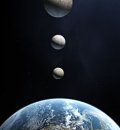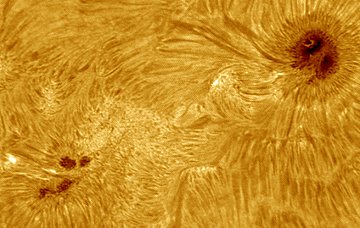 Did you miss the aurora surprise of August 7th? Next time get a wake-up call: Spaceweather PHONE.
Did you miss the aurora surprise of August 7th? Next time get a wake-up call: Spaceweather PHONE.
BACKWARD SUNSPOT: A strange little sunspot noticed by astronomers on July 31st may herald the coming of an unusually stormy solar cycle. Get the full story from Science@NASA.
THE MEANING OF PLANET: What is a planet? For years, astronomers have been debating that question, with the status of tiny Pluto hanging in the balance. Finally, an answer is in the offing. The International Astronomical Union's Planet Definition Committee has proposed a new, official definition:
 "A planet is a celestial body that (a) has sufficient mass for its self-gravity to overcome rigid body forces so that it assumes a hydrostatic equilibrium (nearly round) shape, and (b) is in orbit around a star, and is neither a star nor a satellite of a planet." [full text]
"A planet is a celestial body that (a) has sufficient mass for its self-gravity to overcome rigid body forces so that it assumes a hydrostatic equilibrium (nearly round) shape, and (b) is in orbit around a star, and is neither a star nor a satellite of a planet." [full text]
In plain language, if it's round and it orbits the Sun, then it's a planet.
On August 24th, astronomers gathered at the IAU General Assembly in Prague will vote on the proposal, yea or nay. If it passes, the Solar System will have twelve planets: Mercury, Venus, Earth, Mars, Ceres, Jupiter, Saturn, Uranus, Neptune, Pluto and Charon (a double planet) and 2003 UB313.
Official IAU Press Release
Note: The International Astronomical Union (IAU) is a worldwide organization of distinguished astronomers. It has been the official arbiter of planetary and satellite nomenclature since its founding in 1919.
SUNSPOT 904: Half of double sunspot 904 is disintegrating. Note the fragments on the left in this image from Philippe Vercoutter of Ypres, Belgium:

Above: Sunspot 904, the view through a Coronado SolarMax40.
A few days ago these fragments were a single coherent spot almost as wide as the planet Neptune. Now they seem bent on complete disintegration. Will the big spot on the right follow suit? Stay tuned.
more images: from Rogerio Marcon of São Paulo, Brazil; from Gary Palmer of Los Angeles, California; from Pete Lawrence of Selsey, UK; from Sylvain Weiller of St Rémy les Chevreuse, France.

